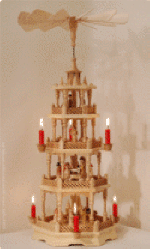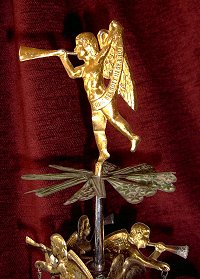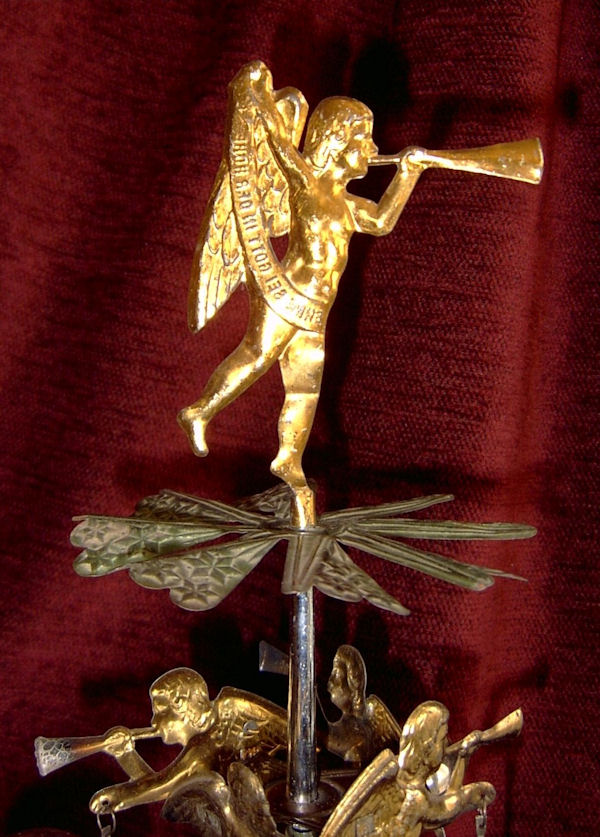|
Introduction &
History
"The Candles burn,
the angels turn"
 or
those of us who grew up with them, candle chimes — or "angel chimes"
as they are popularly known in English-speaking countries — blend light,
motion and sound in a captivating and uniquely seasonal way. To a
child they are magical; but all angel chimes work on
the same relatively simple physical principle: lighted candles create a
warm updraft of air, which moves an impeller carrying small
clappers; as the impeller or
those of us who grew up with them, candle chimes — or "angel chimes"
as they are popularly known in English-speaking countries — blend light,
motion and sound in a captivating and uniquely seasonal way. To a
child they are magical; but all angel chimes work on
the same relatively simple physical principle: lighted candles create a
warm updraft of air, which moves an impeller carrying small
clappers; as the impeller rotates, the clappers ring a set of
chimes. Most of candle chimes were intended as Christmas decorations,
and seasonal figures — particularly angels — are dominant in the design,
either as ornaments, or as supports for the clappers or some other
part of the apparatus. Angels are also prominent in the names of
these toys: "Angel Chimes" in English,
“Engelgeläute” in German, Änglaspelet” in Scandinavia, and
“Enkelikellot” (a term derived directly from the German “Engelgeläute”), “los angelitos” in
Spanish-speaking countries, and “carillon des anges” in France.
However, the
term "angel chimes" in whatever language derives not from
the design of these toys, but from an ancient
popular legend that on Christmas Eve bells throughout the world are
rung by angels announcing the birth of the Christ Child. The legend
was revived in Europe in the nineteenth century, and many pious poems and
stories about it survive from that period. The earliest
“Engelgeläute” take their name from that now-forgotten sentimental
tale, and were originally designed specifically to evoke it. rotates, the clappers ring a set of
chimes. Most of candle chimes were intended as Christmas decorations,
and seasonal figures — particularly angels — are dominant in the design,
either as ornaments, or as supports for the clappers or some other
part of the apparatus. Angels are also prominent in the names of
these toys: "Angel Chimes" in English,
“Engelgeläute” in German, Änglaspelet” in Scandinavia, and
“Enkelikellot” (a term derived directly from the German “Engelgeläute”), “los angelitos” in
Spanish-speaking countries, and “carillon des anges” in France.
However, the
term "angel chimes" in whatever language derives not from
the design of these toys, but from an ancient
popular legend that on Christmas Eve bells throughout the world are
rung by angels announcing the birth of the Christ Child. The legend
was revived in Europe in the nineteenth century, and many pious poems and
stories about it survive from that period. The earliest
“Engelgeläute” take their name from that now-forgotten sentimental
tale, and were originally designed specifically to evoke it.

So much for the name. As for the object itself, one
ancestor of the physical angel chime is the German pyramide
(left),
a candle-powered revolving wooden Christmas toy made in the Erzgebirge
(Ore Mountains) region of Germany from at least the mid-nineteenth
century. This descends in turn from the stationary wooden pyramid set up at Christmas in some German homes
since the Middle Ages (a modern reconstruction is shown below right). The
triangular shape of these “pyramides” represented the Trinity, and
they were often decorated with candles (symbolizing Christ as the
light of the world), the
 Star
of Bethlehem, and other ornaments. The ancient custom of the decorated wooden pyramid
is known to have survived well into modern times, and it appears to
have morphed, first into
the hand-made candle-powered revolving wooden “pyramide,” and later into the sturdier, mass-produced tin
or brass toys we know today as “angel chimes.” (Incidentally,
the stationary medieval pyramide is also an ancestor of our
Christmas tree.) Another and more direct ancestor of the modern angel chime is the candle-powered metal whirligig used
either as an ornament in the boughs of the Christmas tree, or as a
tree-topper. The ad below, which shows examples of both, is from a
German periodical of the early twentieth century. Star
of Bethlehem, and other ornaments. The ancient custom of the decorated wooden pyramid
is known to have survived well into modern times, and it appears to
have morphed, first into
the hand-made candle-powered revolving wooden “pyramide,” and later into the sturdier, mass-produced tin
or brass toys we know today as “angel chimes.” (Incidentally,
the stationary medieval pyramide is also an ancestor of our
Christmas tree.) Another and more direct ancestor of the modern angel chime is the candle-powered metal whirligig used
either as an ornament in the boughs of the Christmas tree, or as a
tree-topper. The ad below, which shows examples of both, is from a
German periodical of the early twentieth century.
But how did these whirligig gadgets develop into the familiar angel chimes
of today? Who
designed the first angel chimes, and when and where were they made?
Since World War II most metal candle chimes have been manufactured
in Sweden, and some makers of modern "Swedish Angel Chimes" would
like you to believe that their product is “an exact replica of a
beautiful old Swedish original.” It's an intriguing claim, and
conveniently
 vague, in that
nobody has ever seen the "beautiful old Swedish original” referred
to. The American firm of Holt Howard put forward an even more
dubious origin for its line of angel chimes: “Many years ago in the
kingdom of Bavaria, a devoted troubadour fashioned the first Angel-abra.
Presented to the beautiful, young Princess Anna along with the
lavish gifts of Knights and Nobles, the troubadour’s offering
captured the fancy of the happy Princess and became her most prized
possession.” Although the story is pure invention, naming Bavaria as the place of origin
for the angel chime is at least in the ballpark, geographically. In
fact, this type of candle chime, its design, and its modern name,
can be traced with certainty to the Westphalian city of Solingen,
to the specific year of 1905, and to the particular manufacturing
firm of Adrian & Stock. vague, in that
nobody has ever seen the "beautiful old Swedish original” referred
to. The American firm of Holt Howard put forward an even more
dubious origin for its line of angel chimes: “Many years ago in the
kingdom of Bavaria, a devoted troubadour fashioned the first Angel-abra.
Presented to the beautiful, young Princess Anna along with the
lavish gifts of Knights and Nobles, the troubadour’s offering
captured the fancy of the happy Princess and became her most prized
possession.” Although the story is pure invention, naming Bavaria as the place of origin
for the angel chime is at least in the ballpark, geographically. In
fact, this type of candle chime, its design, and its modern name,
can be traced with certainty to the Westphalian city of Solingen,
to the specific year of 1905, and to the particular manufacturing
firm of Adrian & Stock.
More Pictures and Information
Follow in the Gallery:
____________________________
Introduction & History
____________________________
Gallery Page One
Adrian & Stock and the Origins of
the "Angel Chime"
____________________________
Gallery Page
Two
Other Pre-WWII Chimes
____________________________
Gallery Page
Three
"Swedish Pattern" and
Other Post-WWII Angel
Chimes
____________________________
|
Please note: the chimes
illustrated on this site are from the
author's personal
collection, and they are not for sale. For those wanting to
buy
particular chimes illustrated here, eBay is the best source. The
author welcomes comments, additions and corrections, particularly
information on manufacturers and variant models, as well
as advertisements and entries
in contemporary catalogs.
Eric Holzenberg
boreas58@verizon.net
|
|


 or
those of us who grew up with them, candle chimes — or "angel chimes"
as they are popularly known in English-speaking countries — blend light,
motion and sound in a captivating and uniquely seasonal way. To a
child they are magical; but all angel chimes work on
the same relatively simple physical principle: lighted candles create a
warm updraft of air, which moves an impeller carrying small
clappers; as the impeller
or
those of us who grew up with them, candle chimes — or "angel chimes"
as they are popularly known in English-speaking countries — blend light,
motion and sound in a captivating and uniquely seasonal way. To a
child they are magical; but all angel chimes work on
the same relatively simple physical principle: lighted candles create a
warm updraft of air, which moves an impeller carrying small
clappers; as the impeller

